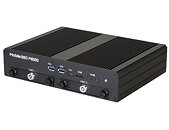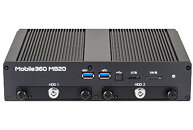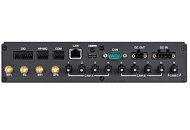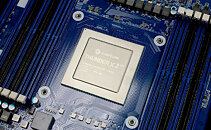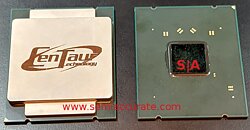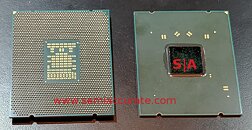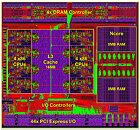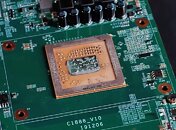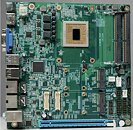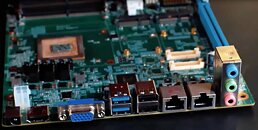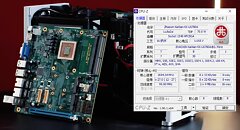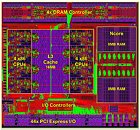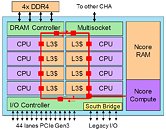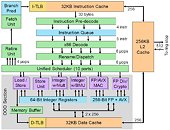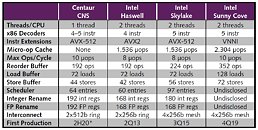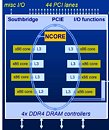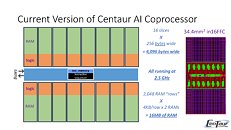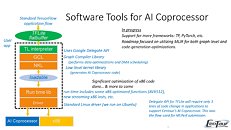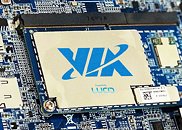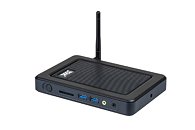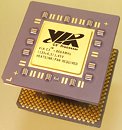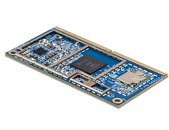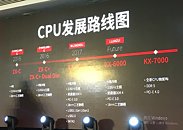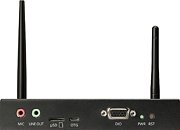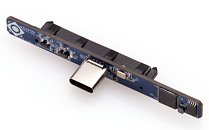Apr 18th, 2025 15:33 EDT
change timezone
Latest GPU Drivers
New Forum Posts
- Can Intel recover in DYI market anytime soon? (9)
- Place your bets, what node will rtx 6000/RDNA 5(UDNA 1?) use (7)
- GPU Pricing and Performance (15)
- What are you playing? (23396)
- TPU's Nostalgic Hardware Club (20256)
- Spoofer Modified SMBIOS/BIOS – Need Help Restoring Original Motherboard Info (TUF GAMING B550-PLUS WiFi II) (2)
- Tried installing 576.02 - installer window disappears (20)
- RX 9000 series GPU Owners Club (392)
- GPU Database (300)
- Drives fail to work with Rufus Windows TO GO (2)
Popular Reviews
- ASUS GeForce RTX 5060 Ti TUF OC 16 GB Review
- NVIDIA GeForce RTX 5060 Ti PCI-Express x8 Scaling
- Palit GeForce RTX 5060 Ti Infinity 3 16 GB Review
- G.SKILL Trident Z5 NEO RGB DDR5-6000 32 GB CL26 Review - AMD EXPO
- ASUS GeForce RTX 5060 Ti Prime OC 16 GB Review
- Teevolution Terra Pro Review
- MSI GeForce RTX 5060 Ti Gaming OC 16 GB Review
- Zotac GeForce RTX 5060 Ti AMP 16 GB Review
- MSI GeForce RTX 5060 Ti Gaming Trio OC 16 GB Review
- ASUS GeForce RTX 5080 TUF OC Review
Controversial News Posts
- NVIDIA GeForce RTX 5060 Ti 16 GB SKU Likely Launching at $499, According to Supply Chain Leak (182)
- NVIDIA Sends MSRP Numbers to Partners: GeForce RTX 5060 Ti 8 GB at $379, RTX 5060 Ti 16 GB at $429 (127)
- Nintendo Confirms That Switch 2 Joy-Cons Will Not Utilize Hall Effect Stick Technology (105)
- Over 200,000 Sold Radeon RX 9070 and RX 9070 XT GPUs? AMD Says No Number was Given (100)
- Nintendo Switch 2 Launches June 5 at $449.99 with New Hardware and Games (99)
- NVIDIA Launches GeForce RTX 5060 Series, Beginning with RTX 5060 Ti This Week (98)
- Sony Increases the PS5 Pricing in EMEA and ANZ by Around 25 Percent (85)
- NVIDIA PhysX and Flow Made Fully Open-Source (77)
News Posts matching #VIA
Return to Keyword BrowsingEpomaker Launches its First Carbon Fiber Keyboard - the Epomaker Carbon 60
This keyboard combines a durable carbon fiber shell with a minimalist design, offering users an unparalleled typing experience and superior usability.
Carbon Fiber Shell and Comfortable Typing Experience
The Epomaker Carbon60 features a durable carbon fiber shell that resists corrosion, oxidation, and scratches, extending its lifespan. Unlike plastic shells, carbon fiber gives the keyboard a more refined and modern feel, enhancing its technological appeal. Paired with stylish spray paint, the Epomaker Carbon 60 exudes a fashionable and sophisticated visual aesthetic, perfectly catering to users who value both performance and appearance. Additionally, the light blue handle design adds a thoughtful touch, making it even more portable.
Carbon Fiber Shell and Comfortable Typing Experience
The Epomaker Carbon60 features a durable carbon fiber shell that resists corrosion, oxidation, and scratches, extending its lifespan. Unlike plastic shells, carbon fiber gives the keyboard a more refined and modern feel, enhancing its technological appeal. Paired with stylish spray paint, the Epomaker Carbon 60 exudes a fashionable and sophisticated visual aesthetic, perfectly catering to users who value both performance and appearance. Additionally, the light blue handle design adds a thoughtful touch, making it even more portable.

YUNZII at CES 2025: Portfolio Updated with a AL65 QMK/VIA Aluminium Keyboard
YUNZII has introduced its latest mechanical keyboard, the AL65 QMK/VIA aluminium keyboard, at CES 2025. The AL65 features a CNC-anodized aluminium frame and a distinctive hollow side-cut design that enhances both its aesthetics and RGB lighting effects. The keyboard is equipped with south-facing LEDs capable of displaying 16.8 million colors, with transparent PC keycaps to amplify the lighting. It supports QMK/VIA, allowing users to remap keys, create macros, and adjust lighting on both Windows and macOS systems. The AL65 offers tri-mode connectivity with wired, Bluetooth, and 2.4 GHz wireless options, powered by an 8000mAh battery for extended use. Its gasket-mounted structure reduces typing noise and provides a softer feel while sound-dampening foam layers minimize vibrations. A hot-swappable PCB supports both 3-pin and 5-pin switches, enabling users to customize the keyboard with different mechanical switches easily. With its robust build, versatile connectivity, and customizable features, the AL65 is designed to cater to a wide range of users, from typists to gamers.

Epomaker Announces the Galaxy 100 Programmable Keyboard
Looking for a customizable keyboard that also delivers on feel and aesthetics? Frustrated that no keyboard on the market meets all your needs? The Galaxy series is here to cater to every layout and customization preference. Introducing Epomaker's latest flagship product: the Galaxy 100!
1800 full-size keyboard with an integrated knob
The Galaxy 100 is an 1800 full-size keyboard equipped with a convenient rotary knob. It offers a complete set of function keys and a numeric keypad, all in a compact design that saves desk space while maximizing functionality. Whether for work or gaming, this keyboard is versatile enough for any scenario. Additionally, it features a handy volume knob for quick audio adjustments, allowing users to control their sound effortlessly without interrupting their workflow or gaming experience.
1800 full-size keyboard with an integrated knob
The Galaxy 100 is an 1800 full-size keyboard equipped with a convenient rotary knob. It offers a complete set of function keys and a numeric keypad, all in a compact design that saves desk space while maximizing functionality. Whether for work or gaming, this keyboard is versatile enough for any scenario. Additionally, it features a handy volume knob for quick audio adjustments, allowing users to control their sound effortlessly without interrupting their workflow or gaming experience.

VIA Announces Three New Platforms That Deliver Advanced Edge AI Capabilities
VIA Technologies, Inc., a leading innovator in the development of embedded platforms and systems, today announced the launch of three new high-performance edge AI solutions: the SOM-5000, VAB-5000, and ARTiGO A5000. These platforms are designed to meet the growing demand for intelligent edge computing across a wide range of industrial, commercial, and consumer applications.
"These new platforms represent a significant leap forward in edge AI technology," said Epan Wu, General Manager, VIA Intelligent Solutions. "With their advanced processing capabilities and versatile connectivity options, the SOM-5000, VAB-5000, and ARTiGO A5000 enable our customers to develop innovative and efficient edge AI applications."
"These new platforms represent a significant leap forward in edge AI technology," said Epan Wu, General Manager, VIA Intelligent Solutions. "With their advanced processing capabilities and versatile connectivity options, the SOM-5000, VAB-5000, and ARTiGO A5000 enable our customers to develop innovative and efficient edge AI applications."

VIA Labs Announces Immediate Availability of USB-IF Certified USB-PD 3.1 EPR Silicon
VIA Labs, Inc. (VLI), a leading supplier of USB4, SuperSpeed USB, and USB Power Delivery Controllers, today announced that the VL108 USB PD 3.1 and DP Alt-mode controller achieved USB-IF certification for USB Power Delivery 3.1 with support for Extended Power Range (EPR). VIA Lab's VL108 is now listed on the USB-IF Integrator's List under TID: 9064.
With the release of the USB Power Delivery 3.1 specification's EPR functionality, the maximum charging rate of USB Type-C was increased from 100 W to 240 W. Previously, the 100 W limit was sufficient for smaller laptops, but higher-powered 15" or larger models with discrete graphics cards often relied on proprietary charging schemes. As certified USB Power Delivery 3.1 silicon with support for EPR becomes available, many vendors are preparing to launch products featuring the new charging modes by the end of the year.
With the release of the USB Power Delivery 3.1 specification's EPR functionality, the maximum charging rate of USB Type-C was increased from 100 W to 240 W. Previously, the 100 W limit was sufficient for smaller laptops, but higher-powered 15" or larger models with discrete graphics cards often relied on proprietary charging schemes. As certified USB Power Delivery 3.1 silicon with support for EPR becomes available, many vendors are preparing to launch products featuring the new charging modes by the end of the year.

VIA Returns to Work in Truck Show 2023
VIA Technologies, Inc. today announced that it will be returning to Work Truck Week 2023 with a range of their market-leading VIA Intelligent Automotive Solutions. Taking place in Indianapolis from March 7 - 10, the VIA booth is located at #4821 in the Indiana Convention Center.
In the midst of ever-increasing demand for video telematic systems, VIA Intelligent Automotive Solutions offer flexible, easy-to-install products, which provide real-time visibility of vehicles and drivers. By integrating video and real-time data analytics, fleet managers can improve route planning, minimize delays, and prevent accidents. When combined with the power of the cloud, tasks such as monitoring fuel usage, optimizing routing, and identifying inefficiencies in supply chains can be performed much more easily and proactively.
In the midst of ever-increasing demand for video telematic systems, VIA Intelligent Automotive Solutions offer flexible, easy-to-install products, which provide real-time visibility of vehicles and drivers. By integrating video and real-time data analytics, fleet managers can improve route planning, minimize delays, and prevent accidents. When combined with the power of the cloud, tasks such as monitoring fuel usage, optimizing routing, and identifying inefficiencies in supply chains can be performed much more easily and proactively.

VIA Announces the SOM-9X35 Edge-AI Starter Kit
VIA Technologies, Inc. today announced the launch of the VIA SOM-9X35 Starter Kit to accelerate time-to-market for retail, commercial, and industrial Edge AI devices. Featuring a flexible high-performance platform powered by the quad-core MediaTek i350 processor, the starter kit comes with a 7" LCD panel and touch panel display, a 13MP HD camera module, and dual speakers and microphone to provide a tightly integrated package for jumpstarting device development. Dual-band 802.11 ac Wi-Fi, Ethernet, Bluetooth 5.0, and optional 4G support provide the seamless connectivity required for myriad use cases.
"As AI moves increasingly to the edge, the demand for powerful and affordable edge devices with the power and flexibility to run intelligent vision applications such as facial, object, gesture, and motion recognition is rising at an exponential rate," commented Richard Brown, VP of International Marketing, VIA Technologies, Inc. "By combining the core compute, video, and display components in a single package, the VIA SOM-9X35 Starter Kit enables our customers to jumpstart the development of innovative devices to take advantage of these burgeoning market opportunities."
"As AI moves increasingly to the edge, the demand for powerful and affordable edge devices with the power and flexibility to run intelligent vision applications such as facial, object, gesture, and motion recognition is rising at an exponential rate," commented Richard Brown, VP of International Marketing, VIA Technologies, Inc. "By combining the core compute, video, and display components in a single package, the VIA SOM-9X35 Starter Kit enables our customers to jumpstart the development of innovative devices to take advantage of these burgeoning market opportunities."

VIA Labs Announces Launch of USB4 Device Silicon
VIA Labs, Inc. (VLI), a leading supplier of SuperSpeed USB, USB Power Delivery Controllers, and now USB4 controllers today unveiled the VIA Labs VL830 USB4 Endpoint Device. USB4 is a major update to the USB architecture, enabling multiple simultaneous data and display protocols to share a single high-speed link with support for a maximum aggregate bandwidth of 40 Gbps. VL830 offers both USB and DisplayPort functionality and operates at full performance when used with Thunderbolt 4 or USB4 systems, and is also backward compatible with previous-generation devices such as laptops, tablets, and phones that support DisplayPort Alternate Mode over USB Type-C.
"VIA Labs VL830 represents a culmination of our experience in developing USB Type-C, USB Power Delivery, and USB 3.2 products, an industry leader in time to market, and contribution and participation in standards development," said Terrance Shih, Business Development Director, VIA Labs, Inc. "USB4 is based on Thunderbolt technology and we are very excited to deliver these capabilities at new price points."
"VIA Labs VL830 represents a culmination of our experience in developing USB Type-C, USB Power Delivery, and USB 3.2 products, an industry leader in time to market, and contribution and participation in standards development," said Terrance Shih, Business Development Director, VIA Labs, Inc. "USB4 is based on Thunderbolt technology and we are very excited to deliver these capabilities at new price points."
Zhaoxin to Design Discrete GPUs
Zhaoxin, the Chinese chip-maker famous for Kaixian line of x86 processors, and a major beneficiary of the Chinese government's ambitious "3-5-2 plan" of public investment toward the country's computer hardware independence by the mid-2020s, unveiled plans to design its first discrete GPUs that could double up as scalar-compute and AI processors. The company's baby step is a tiny 70-Watt dGPU that will be fabricated on TSMC's 28 nm silicon fabrication process that will likely serve as a tech demonstrator and development platform for ISVs. The dGPU is largely expected to derive from VIA's S3 Graphics IP as VIA has collaborated with Zhaoxin as an iGPU provider for its Kaixian line of x86 SoCs.

VIA Announces AWS IoT Greengrass Qualified VIA Mobile360 M820
VIA Technologies, Inc. today announced that it has received AWS IoT Greengrass certification for the VIA Mobile360 M820 in-vehicle safety system. AWS IoT Greengrass seamlessly extends AWS services to edge devices and allows the systems to act in real-time using locally generated data when an internet network connection is not available - a vital feature for vehicles on the road.
"AWS Greengrass IoT certification for the VIA Mobile360 M820 underlines our commitment to providing an optimized deployment path for operators to enable AWS services across their vehicle fleets," commented Richard Brown, VP of International Marketing, VIA Technologies, Inc. "This highly-integrated solution accelerates the integration of advanced fleet management and in-vehicle safety applications from the edge to the cloud."
"AWS Greengrass IoT certification for the VIA Mobile360 M820 underlines our commitment to providing an optimized deployment path for operators to enable AWS services across their vehicle fleets," commented Richard Brown, VP of International Marketing, VIA Technologies, Inc. "This highly-integrated solution accelerates the integration of advanced fleet management and in-vehicle safety applications from the edge to the cloud."

x86 Lacks Innovation, Arm is Catching up. Enough to Replace the Giant?
Intel's x86 processor architecture has been the dominant CPU instruction set for many decades, since IBM decided to put the Intel 8086 microprocessor into its first Personal Computer. Later, in 2006, Apple decided to replace their PowerPC based processors in Macintosh computers with Intel chips, too. This was the time when x86 became the only option for the masses to use and develop all their software on. While mobile phones and embedded devices are mostly Arm today, it is clear that x86 is still the dominant ISA (Instruction Set Architecture) for desktop computers today, with both Intel and AMD producing processors for it. Those processors are going inside millions of PCs that are used every day. Today I would like to share my thoughts on the demise of the x86 platform and how it might vanish in favor of the RISC-based Arm architecture.
Both AMD and Intel as producer, and millions of companies as consumer, have invested heavily in the x86 architecture, so why would x86 ever go extinct if "it just works"? The answer is that it doesn't just work.
Both AMD and Intel as producer, and millions of companies as consumer, have invested heavily in the x86 architecture, so why would x86 ever go extinct if "it just works"? The answer is that it doesn't just work.

VIA CenTaur CHA NCORE AI CPU Pictured, a Socketed LGA Package
VIA's CenTaur division sprung an unexpected surprise in the CPU industry with its new CHA x86-64 microarchitecture and an on-die NCORE AI co-processor. This would be the first globally-targeted x86 processor launch by a company other than Intel and AMD in close to 7 years, and VIA's first socketed processor in over 15 years. SemiAccurate scored a look at mock-up of the CenTaur CHA NCORE 8-core processor and it turns out that the chip is indeed socketed.
Pictured below, the processor is a flip-chip LGA. We deduce it is socketed looking at its alignment notches and traces for ancillaries on the reverse-side (something BGAs tend to lack). On the other hand, the "contact points" of the package appear to cast shadows, and resemble balls on a BGA package. Topside, we see an integrated heatspreader (IHS), and underneath is a single square die. CenTaur built the CHA NCORE on TSMC's 16 nm FinFET process. The package appears to have quite a high pin-count for a die this size, but that's probably because of its HEDT-rivaling I/O, which includes a quad-channel DDR4 memory interface and 44 PCI-Express gen 3.0 lanes.
Pictured below, the processor is a flip-chip LGA. We deduce it is socketed looking at its alignment notches and traces for ancillaries on the reverse-side (something BGAs tend to lack). On the other hand, the "contact points" of the package appear to cast shadows, and resemble balls on a BGA package. Topside, we see an integrated heatspreader (IHS), and underneath is a single square die. CenTaur built the CHA NCORE on TSMC's 16 nm FinFET process. The package appears to have quite a high pin-count for a die this size, but that's probably because of its HEDT-rivaling I/O, which includes a quad-channel DDR4 memory interface and 44 PCI-Express gen 3.0 lanes.
Zhaoxin KaiXian x86 Processor Now Commercially Available to the DIY Channel
Zhaoxin is a brand that makes multi-core 64-bit x86 processors primarily for use in Chinese state IT infrastructure. It's part of the Chinese Government's ambitious plan to make its IT hardware completely indigenous. Zhaoxin's x86-64 CPU cores are co-developed by licensee VIA, specifically its CenTaur subsidiary that's making NCORE AI-enabled x86 processors. The company's KaiXian KX-6780A processor is now commercially available in China to the DIY market in the form of motherboards with embedded processors.
The KaiXian KX-6780A features an 8-core/8-thread x86-64 CPU clocked up to 2.70 GHz, 8 MB of last-level cache, a dual-channel DDR4-3200 integrated memory controller, a PCI-Express gen 3.0 root-complex, and an iGPU possibly designed by VIA's S3 Graphics division, which supports basic display and DirectX 11.1 readiness. The CPU features modern ISA, with instruction sets that include AVX, AES-NI, SHA-NI, and VT-x comparable virtualization extensions. The chip has been fabricated on TSMC 16 nm FinFET process.
The KaiXian KX-6780A features an 8-core/8-thread x86-64 CPU clocked up to 2.70 GHz, 8 MB of last-level cache, a dual-channel DDR4-3200 integrated memory controller, a PCI-Express gen 3.0 root-complex, and an iGPU possibly designed by VIA's S3 Graphics division, which supports basic display and DirectX 11.1 readiness. The CPU features modern ISA, with instruction sets that include AVX, AES-NI, SHA-NI, and VT-x comparable virtualization extensions. The chip has been fabricated on TSMC 16 nm FinFET process.

Centaur Releases In-Depth Analysis from The Linley Group for its NCORE-Equipped x86 Processor
Centaur Technology today revealed in-depth information about its new processor-design technology for integrating high-performance x86 CPUs with a specialized co-processor optimized for artificial intelligence (AI) acceleration. On its website, Centaur provides a new independent report from The Linley Group, the industry's leading authority on microprocessor technology and publishers of Microprocessor Report. The Linley Group reviewed Centaur's detailed design documents and interviewed Centaur's CPU and AI architects to support the analysis of both Centaur's newest x86 microarchitecture and the AI co-processor design.
"Centaur is galloping back into the x86 market with an innovative processor design that combines eight high-performance CPUs with a custom deep-learning accelerator (DLA). The company is the first to announce a server-processor design that integrates a DLA. The new accelerator, called Ncore, delivers better neural-network performance than even the most powerful Xeon, but without the high cost of an external GPU card," stated Linley Gwennap, Editor-in-Chief, Microprocessor Report.The report can be accessed here (PDF).
"Centaur is galloping back into the x86 market with an innovative processor design that combines eight high-performance CPUs with a custom deep-learning accelerator (DLA). The company is the first to announce a server-processor design that integrates a DLA. The new accelerator, called Ncore, delivers better neural-network performance than even the most powerful Xeon, but without the high cost of an external GPU card," stated Linley Gwennap, Editor-in-Chief, Microprocessor Report.The report can be accessed here (PDF).

VIA CenTaur Develops a Multi-core x86 Processor for Enterprise with in-built AI Hardware
Tasting Intel's blood in the water with AMD's return to competitiveness, dormant x86 licensee VIA wants to take another swing at the market, this time with a multi-core processor targeted at enterprises and possibly workstations, developed by its subsidiary CenTaur. The company appears to want to cash in on the AI boom, and could develop turnkey facial-recognition CCTV solutions with the chip. CenTaur is ready with a working prototype. It features eight 64-bit x86 CPU cores, and an on-die "AI co-processor" named NCORE. A ringbus connects the eight CPU cores and the NCORE with the processor's other components. The processor features 16 MB of shared L3 cache, a quad-channel DDR4-3200 memory interface, and a 44-lane PCI-Express gen 3.0 root-complex, along with a fully integrated southbridge, making it an SoC. It also appears to be multi-socket capable, although VIA didn't detail the interconnect in use.
The NCORE is a PCI-mapped device to the software, which provides functions such as DNN building and training acceleration. From the looks of it, there's more to NCORE than simply a fixed-function hardware that multiplies matrices. Its developers state that the device accelerates AI at a rate of "20 trillion AI operations/sec with 20 terabytes/sec memory bandwidth." The CPU cores on the processor tick at 2.50 GHz, and while VIA hasn't made any IPC claims, it has mentioned support for the cutting-edge AVX-512 instruction-set, something even "Zen 2" lacks, which possibly indicates a powerful FPU. The silicon measures 195 mm², and has been built on 16 nm FinFET node at TSMC. VIA will demonstrate the unnamed processor and its testbed at ISC East 2019, held on November 20 and 21.The full technology announcement slide-deck follows.
The NCORE is a PCI-mapped device to the software, which provides functions such as DNN building and training acceleration. From the looks of it, there's more to NCORE than simply a fixed-function hardware that multiplies matrices. Its developers state that the device accelerates AI at a rate of "20 trillion AI operations/sec with 20 terabytes/sec memory bandwidth." The CPU cores on the processor tick at 2.50 GHz, and while VIA hasn't made any IPC claims, it has mentioned support for the cutting-edge AVX-512 instruction-set, something even "Zen 2" lacks, which possibly indicates a powerful FPU. The silicon measures 195 mm², and has been built on 16 nm FinFET node at TSMC. VIA will demonstrate the unnamed processor and its testbed at ISC East 2019, held on November 20 and 21.The full technology announcement slide-deck follows.

VIA Partners with Lucid to Develop Industry-Leading VIA Edge AI 3D Developer Kit
VIA Technologies, Inc today announces that it is partnering with AI vision startup Lucid, to deliver AI-based depth sensing capabilities to more dual- and multi-camera devices in the security, retail, robotics and autonomous vehicle space. With Lucid's proprietary 3D Fusion Technology embedded into the VIA Edge AI 3D Developer Kit, security and retail cameras, robots, drones, and autonomous vehicles will now be able to easily capture accurate depth and 3D with dual- or multi-camera setups while reducing the costs, power, and space consumption of previous hardware depth solutions. As VIA builds out its long-term Edge AI solutions roadmap, Lucid is adding camera- and machine-learning based depth capabilities on top of every platform.
The AI-enhanced 3D/depth solution developed by Lucid, known as 3D Fusion Technology, is currently deployed in many devices such as 3D cameras, security cameras, robots, and mobile phones, including the RED Hydrogen One which is launching in November without any additional emission or laser-based hardware components. In the VIA Edge AI 3D Developer Kit, the AI depth solution runs on the Qualcomm APQ8096SG embedded processor, which features the Qualcomm AI Engine along with support for multiple cameras to help Lucid provide superior performance compared to other hardware depth solutions and deliver an industry-leading and unique pure machine learning-based software solution.
The AI-enhanced 3D/depth solution developed by Lucid, known as 3D Fusion Technology, is currently deployed in many devices such as 3D cameras, security cameras, robots, and mobile phones, including the RED Hydrogen One which is launching in November without any additional emission or laser-based hardware components. In the VIA Edge AI 3D Developer Kit, the AI depth solution runs on the Qualcomm APQ8096SG embedded processor, which features the Qualcomm AI Engine along with support for multiple cameras to help Lucid provide superior performance compared to other hardware depth solutions and deliver an industry-leading and unique pure machine learning-based software solution.

VIA Launches ALTA DS 3 Edge AI System Powered by Qualcomm Snapdragon 820E
VIA Technologies, Inc., today announced the launch of the VIA ALTA DS 3 Edge AI system. Powered by the Qualcomm Snapdragon 820E Embedded Platform, the system enables the rapid development and deployment of intelligent signage, kiosk, and access control devices that require real-time image and video capture, processing, and display capabilities.
The VIA ALTA DS 3 harnesses the cutting-edge compute, graphics, and AI processing capabilities of the Qualcomm Snapdragon 820E Embedded Platform to facilitate the creation of vibrant new user experiences by allowing customers to combine their own AI applications with immersive multimedia signage display content in a compact, low-power system.
The VIA ALTA DS 3 harnesses the cutting-edge compute, graphics, and AI processing capabilities of the Qualcomm Snapdragon 820E Embedded Platform to facilitate the creation of vibrant new user experiences by allowing customers to combine their own AI applications with immersive multimedia signage display content in a compact, low-power system.

VIA C3 Processors Compromised by a Simple Shell Command
VIA processors probably make up an infinitesimal amount of the desktop PC market-share, and its makers market the chip only at pre-built machines such as digital-signage kiosks, information kiosks, ticket vending machines, ATMs, etc (which don't need a lot of processing power). At the Black Hat 2018 conference, security researcher Christopher Domas discovered that getting access to root privileges in Linux on a machine powered by VIA C3 "Nehemiah" processors is laughably easy. Just key in ".byte 0x0f, 0x3f" (without quotes) in any Linux CLI in user mode, and voila! You are now the root user.
Domas calls this his own iddqd (the cheat-code for "God Mode" in "Doom"). This backdoor, probably put in place by the processor's designers themselves, completely collapses the ring-based privilege system of the operating system, and elevates users and applications from the ring-2 (and above) userspace to ring 0 (root). It is an exploitation of a shadow-core, a hidden RISC processor within C7, which manages the startup, operation, and key storage of the x86 cores. Intel and AMD too have shadow-cores with similar functions.
Domas calls this his own iddqd (the cheat-code for "God Mode" in "Doom"). This backdoor, probably put in place by the processor's designers themselves, completely collapses the ring-based privilege system of the operating system, and elevates users and applications from the ring-2 (and above) userspace to ring 0 (root). It is an exploitation of a shadow-core, a hidden RISC processor within C7, which manages the startup, operation, and key storage of the x86 cores. Intel and AMD too have shadow-cores with similar functions.

VIA Launches VIA Edge AI Developer Kit
VIA Technologies, Inc., today announced the launch of the VIA Edge AI Developer Kit, a highly-integrated package powered by the Qualcomm Snapdragon 820E Embedded Platform that simplifies the design, testing, and deployment of intelligent Edge AI systems and devices.
The kit combines the VIA SOM-9X20 SOM Module and SOMDB2 Carrier Board with a 13MP camera module that is optimized for intelligent real-time video capture, processing, and edge analysis. Edge AI application development is enabled by an Android 8.0 BSP, which includes support for the Snapdragon Neural Processing Engine (NPE) and full acceleration of the Qualcomm Hexagon DSP, Qualcomm Adreno 530 GPU, or Qualcomm Kryo CPU to power AI applications. A Linux BSP based on Yocto 2.0.3 is set to be released in June this year.
The kit combines the VIA SOM-9X20 SOM Module and SOMDB2 Carrier Board with a 13MP camera module that is optimized for intelligent real-time video capture, processing, and edge analysis. Edge AI application development is enabled by an Android 8.0 BSP, which includes support for the Snapdragon Neural Processing Engine (NPE) and full acceleration of the Qualcomm Hexagon DSP, Qualcomm Adreno 530 GPU, or Qualcomm Kryo CPU to power AI applications. A Linux BSP based on Yocto 2.0.3 is set to be released in June this year.

Toshiba-OCZ Announce XS700 Series Portable SSDs
Toshiba subsidiary OCZ rolled out the XS700 series portable SSDs. Measuring 95 mm x 75 mm x 11 mm, the drive is only slightly bigger than an internal 2.5-inch drive, and features an aluminium body with diamond-cut edges. The drive features USB 3.1 Gen 2 (10 Gbps) interface, with backwards compatibility to older USB generations. A single cable plugging into the drive's type-C connector provides both power and host connectivity.
Under the hood, the OCZ XS700 features Toshiba-made 3D BiCS TLC NAND flash memory. It comes in only a 240 GB capacity for now, which offers sequential reads of up to 530 MB/s, and sequential write speeds of up to 480 MB/s. The drive appears to feature two components, a Phison S11 DRAM-less controller wired to the NAND flash, connected over SATA 6 Gbps to a VIA Labs VL715 chip that connects it to the USB 3.1 Gen 2 interface. You also get USB-attached SCSI protocol (UASP) support, to speed things up. The drive is backed by a 3-year warranty, and is expected to be priced around $200, when it hits the shelves later this month.
Under the hood, the OCZ XS700 features Toshiba-made 3D BiCS TLC NAND flash memory. It comes in only a 240 GB capacity for now, which offers sequential reads of up to 530 MB/s, and sequential write speeds of up to 480 MB/s. The drive appears to feature two components, a Phison S11 DRAM-less controller wired to the NAND flash, connected over SATA 6 Gbps to a VIA Labs VL715 chip that connects it to the USB 3.1 Gen 2 interface. You also get USB-attached SCSI protocol (UASP) support, to speed things up. The drive is backed by a 3-year warranty, and is expected to be priced around $200, when it hits the shelves later this month.

VIA Making a Comeback to x86 CPU Market with Zhaoxin R&D Monies
The only other active x86 architecture licensee than AMD, VIA Technologies, is planning a comeback to the x86 processor market, bolstered by R&D investment by Shanghai Zhaoxin Semiconductor. VIA and Zhaoxin have been co-developing the ZX family of x86 processors for rollout in 2018, and at least on paper, the chips appear to have the chops to take on Intel's "Gemini Lake" SoCs. The new VIA-Zhaoxin combine CPU family begins with the KX-5000 "Wudaoku" SoCs launched late-2017. These are full-fledged SoCs, which completely integrate the chipset (including the southrbidge).
The KX-5000 chips feature 4 or 8 CPU cores without SMT, 2.00-2.20 GHz nominal CPU clock, 2.40 GHz boost clock, a dual-channel DDR4 IMC, a PCI-Express gen 3.0 root complex, an integrated graphics core, and platform I/O that includes SATA 6 Gbps, and USB 3.1 gen 2. This chip debuted on only one product from a major OEM, the Lenovo M6200 desktop model launched in China. 2018 could see a broader launch of VIA-Zhaoxin chips, with the KX-6000. While the older chips were built on the 28 nm process, the KX-6000 series will be built on the newer 16 nm process, feature 4 or 8 CPU cores clocked at speeds of up to 3.00 GHz, while retaining the feature-set of the KX-5000 series. These chips could realistically be touted as low-cost alternatives to Intel "Gemini Lake" SoCs, although Zhaoxin is making bold claims about its performance nearing that of AMD Ryzen processors.
The KX-5000 chips feature 4 or 8 CPU cores without SMT, 2.00-2.20 GHz nominal CPU clock, 2.40 GHz boost clock, a dual-channel DDR4 IMC, a PCI-Express gen 3.0 root complex, an integrated graphics core, and platform I/O that includes SATA 6 Gbps, and USB 3.1 gen 2. This chip debuted on only one product from a major OEM, the Lenovo M6200 desktop model launched in China. 2018 could see a broader launch of VIA-Zhaoxin chips, with the KX-6000. While the older chips were built on the 28 nm process, the KX-6000 series will be built on the newer 16 nm process, feature 4 or 8 CPU cores clocked at speeds of up to 3.00 GHz, while retaining the feature-set of the KX-5000 series. These chips could realistically be touted as low-cost alternatives to Intel "Gemini Lake" SoCs, although Zhaoxin is making bold claims about its performance nearing that of AMD Ryzen processors.

VIA Announces VIA ARTiGO A630 Enterprise IoT Gateway System
VIA Technologies, Inc., today announced the launch of the VIA ARTiGO A630, an ultra-slim fanless gateway system with flexible customization options for a broad spectrum of commercial M2M and IoT applications. Featuring a high-performance 1.0GHz VIA Cortex-A9 dual-core SoC, multiple network connectivity options, and a rich combination of I/O, the VIA ARTiGO A630 adds a cost-effective solution to the growing range of VIA Enterprise IoT gateway devices designed to manage the connection and control for a wide spectrum of connected HMI and automation applications.
"The VIA ARTiGO A630 bolsters our already diverse range of ARTiGO Series M2M and IoT gateway systems," said Richard Brown, VP International Marketing, VIA Technologies, Inc. "Providing a rich mix of connectivity and performance in an ultra-compact design that can be rapidly customized, will help customers speed time-to-market and unlock the full potential of their IoT deployments."
"The VIA ARTiGO A630 bolsters our already diverse range of ARTiGO Series M2M and IoT gateway systems," said Richard Brown, VP International Marketing, VIA Technologies, Inc. "Providing a rich mix of connectivity and performance in an ultra-compact design that can be rapidly customized, will help customers speed time-to-market and unlock the full potential of their IoT deployments."

VIA Labs VL820 becomes the World's First USB-IF Certified USB 3.1 Gen 2 Hub
VIA Labs, Inc., a leading supplier of SuperSpeed USB and USB Power Delivery Controllers, today announced that the VIA Labs VL820 USB 3.1 Gen 2 Hub Controller has achieved SuperSpeed USB 10 Gbps certification from the USB Implementers Forum (USB-IF). The VIA Labs VL820 is the world's first USB-IF Certified USB 3.1 Gen 2 Hub.
The VIA Labs VL820 features one upstream port and four downstream ports, each capable of supporting SuperSpeed USB 10Gbps devices, while providing backward compatibility for previous generation USB devices. The VIA Labs VL820 was designed with USB-C in mind, integrating an optionally configurable USB Billboard Device for Alternate Mode applications such as Thunderbolt 3 peripherals or DisplayPort over USB-C multi-function dongles.
The VIA Labs VL820 features one upstream port and four downstream ports, each capable of supporting SuperSpeed USB 10Gbps devices, while providing backward compatibility for previous generation USB devices. The VIA Labs VL820 was designed with USB-C in mind, integrating an optionally configurable USB Billboard Device for Alternate Mode applications such as Thunderbolt 3 peripherals or DisplayPort over USB-C multi-function dongles.

VIA Announces First USB 3.1 to SATA Single-chip Bridge with USB-IF Certification
VIA Labs, Inc., a leading supplier of SuperSpeed USB and Power Delivery Controllers, today announced that the VIA Labs VL716 USB 3.1 to SATA III Bridge Controller with native USB Type-C support has achieved SuperSpeed USB 10 Gbps certification from the USB Implementers Forum (USB-IF). Optimized for the latest USB Type-C external storage applications such as USB Type-C optical drives, SSD's, and HDD's, the VL716 single-chip USB 3.1 Gen 2 to SATA III Bridge Controller offers blazing data transfer rates up to 10 Gbps and is fully backwards compatible with USB 3.1 Gen 1, USB High-Speed, and USB Full-Speed modes. With native USB Type-C support built-in, the VL716 offers advanced features such as USB-C connector orientation detection and USB Mux to enable the reversibility feature without additional components or cost.
"Integrating SuperSpeed USB 10 Gbps and USB Type-C support minimizes the need for multiple components and reduces cost for developers," said Jeff Ravencraft, USB-IF President and COO. "Companies like VIA Labs are growing the USB ecosystem by developing compliant solutions and submitting products for USB-IF compliance testing."
"Integrating SuperSpeed USB 10 Gbps and USB Type-C support minimizes the need for multiple components and reduces cost for developers," said Jeff Ravencraft, USB-IF President and COO. "Companies like VIA Labs are growing the USB ecosystem by developing compliant solutions and submitting products for USB-IF compliance testing."

VIA to Unveil its Latest SSD Controllers at FMS 2016
VIA Technologies, Inc, today announced that it be will demonstrating its latest VIA NVMe PCIe Gen III & SATA III SSD controllers in Booth#818 of the 2016 Flash Memory Summit being held from August 9th to 11th in the Santa Clara Convention Center, California, USA. Featuring the VIA LDPC PLUS ECC decoding engine with Gear-Shifting technology, the second generation VIA SSD controllers offer best-in-class error correction capability and ensure high-throughput performance without overheating issues.
"VIA Gear-Shifting technology leverages our unique dual hardware decoding architecture to maximize data integrity and longevity," said Richard Brown, VP International Marketing, VIA Technologies, Inc. "Our second generation VIA SSD controllers are the ideal choice for computing devices that require superior SSD performance with high cost-efficiency."
"VIA Gear-Shifting technology leverages our unique dual hardware decoding architecture to maximize data integrity and longevity," said Richard Brown, VP International Marketing, VIA Technologies, Inc. "Our second generation VIA SSD controllers are the ideal choice for computing devices that require superior SSD performance with high cost-efficiency."
Apr 18th, 2025 15:33 EDT
change timezone
Latest GPU Drivers
New Forum Posts
- Can Intel recover in DYI market anytime soon? (9)
- Place your bets, what node will rtx 6000/RDNA 5(UDNA 1?) use (7)
- GPU Pricing and Performance (15)
- What are you playing? (23396)
- TPU's Nostalgic Hardware Club (20256)
- Spoofer Modified SMBIOS/BIOS – Need Help Restoring Original Motherboard Info (TUF GAMING B550-PLUS WiFi II) (2)
- Tried installing 576.02 - installer window disappears (20)
- RX 9000 series GPU Owners Club (392)
- GPU Database (300)
- Drives fail to work with Rufus Windows TO GO (2)
Popular Reviews
- ASUS GeForce RTX 5060 Ti TUF OC 16 GB Review
- NVIDIA GeForce RTX 5060 Ti PCI-Express x8 Scaling
- Palit GeForce RTX 5060 Ti Infinity 3 16 GB Review
- G.SKILL Trident Z5 NEO RGB DDR5-6000 32 GB CL26 Review - AMD EXPO
- ASUS GeForce RTX 5060 Ti Prime OC 16 GB Review
- Teevolution Terra Pro Review
- MSI GeForce RTX 5060 Ti Gaming OC 16 GB Review
- Zotac GeForce RTX 5060 Ti AMP 16 GB Review
- MSI GeForce RTX 5060 Ti Gaming Trio OC 16 GB Review
- ASUS GeForce RTX 5080 TUF OC Review
Controversial News Posts
- NVIDIA GeForce RTX 5060 Ti 16 GB SKU Likely Launching at $499, According to Supply Chain Leak (182)
- NVIDIA Sends MSRP Numbers to Partners: GeForce RTX 5060 Ti 8 GB at $379, RTX 5060 Ti 16 GB at $429 (127)
- Nintendo Confirms That Switch 2 Joy-Cons Will Not Utilize Hall Effect Stick Technology (105)
- Over 200,000 Sold Radeon RX 9070 and RX 9070 XT GPUs? AMD Says No Number was Given (100)
- Nintendo Switch 2 Launches June 5 at $449.99 with New Hardware and Games (99)
- NVIDIA Launches GeForce RTX 5060 Series, Beginning with RTX 5060 Ti This Week (98)
- Sony Increases the PS5 Pricing in EMEA and ANZ by Around 25 Percent (85)
- NVIDIA PhysX and Flow Made Fully Open-Source (77)



























